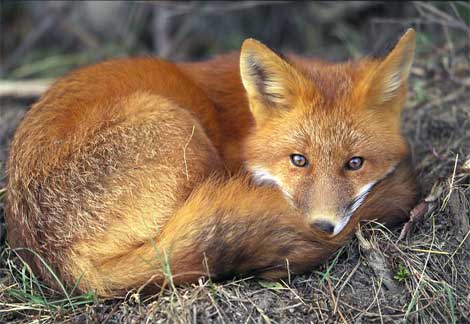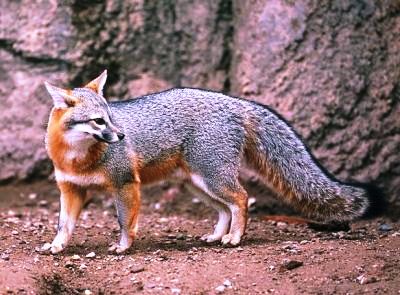Discover Florida Nature
It's time to explore the natural Florida


|
|
|
|
|
 The
red fox (Vulpes vulpes) has the appearance of a small dog and
weighs from 10 to 15 pounds and measures up to 2 feet long with
another foot for a bushy tail. The end of the tail is black, tipped with
white. The Red Fox is most commonly a rusty red, with white underbelly,
black ear tips and legs, and a bushy tail usually with a distinctive
white tip. The "red" tone can vary from dark chestnut to golden. Because
the gray fox frequently has quite a lot of red hair, it may be confused
with the red fox. The red fox is essentially a nocturnal animal,
but it occasionally feeds during the day, and more at dawn and dusk. The
red fox (Vulpes vulpes) has the appearance of a small dog and
weighs from 10 to 15 pounds and measures up to 2 feet long with
another foot for a bushy tail. The end of the tail is black, tipped with
white. The Red Fox is most commonly a rusty red, with white underbelly,
black ear tips and legs, and a bushy tail usually with a distinctive
white tip. The "red" tone can vary from dark chestnut to golden. Because
the gray fox frequently has quite a lot of red hair, it may be confused
with the red fox. The red fox is essentially a nocturnal animal,
but it occasionally feeds during the day, and more at dawn and dusk.The red fox is probably not native to Florida except in the northern Panhandle. It has been introduced by hunting clubs, and is now found in many areas of the state. The red fox is normally found in uplands mixed with fields and weedy pastures. Unlike the gray fox it avoids heavily wooded areas. Red Foxes are largely carnivorous. Red foxes are solitary hunters and the majority of their diet consists of invertebrates, such as insects, mollusks, earthworms and crayfish. They do also eat some plant material, especially blackberries, apples, plums and other fruit. Common vertebrate prey includes mice, rabbits, birds, eggs, frog, small reptiles, fish, and even worms. They usually hunt alone. With their acute sense of hearing, they can locate small mammals in thick grass, and they jump high in the air to pounce on the prey. They also stalk prey such as rabbits, keeping hidden until close enough to catch them in a short dash. Foxes tend to be extremely possessive of their food and will not share it with others. If food is plentiful, they may kill more than they immediately need, and cache the extra in the ground. Breeding takes place in late fall or early winter. A pair usually mates for life. An average of 5 pups are born after a gestation period of about 53 days. At birth the pups are blind, helpless, and brownish-black. They nurse for about two months and stay with their parents for about 6 months. The den site is usually a dug out underground burrow, through they sometimes may enlarge the burrow of gopher tortoise or armadillo. The dens are usually 20-40 feet long and 3-4 deep, with multiple entrances.  Because
the gray fox (Urocyon cinereoargenteus) frequently has quite a
lot of red hair, it may be confused with the red fox, and is sometimes
referred to as a "red-sided gray". The adult gray fox may weigh from 7
to 13 pounds and measure up to 40 inches including a 12 inch
tail. The female is slightly smaller than the male. The hair along the
middle of the back and tail is tipped in black and has the appearance of
a black mane. The face, sides, back, and tail are gray, while the under
parts are white and the sides of the neck and underside of the tail a
rusty-yellow color. The gray fox is essentially a nocturnal
animal, and while seldom recognized, it has a yapping bark. The gray fox
sometimes referred to as the "tree fox" can scramble-up a tree quickly,
and is the only member of the dog family capable of climbing. Because
the gray fox (Urocyon cinereoargenteus) frequently has quite a
lot of red hair, it may be confused with the red fox, and is sometimes
referred to as a "red-sided gray". The adult gray fox may weigh from 7
to 13 pounds and measure up to 40 inches including a 12 inch
tail. The female is slightly smaller than the male. The hair along the
middle of the back and tail is tipped in black and has the appearance of
a black mane. The face, sides, back, and tail are gray, while the under
parts are white and the sides of the neck and underside of the tail a
rusty-yellow color. The gray fox is essentially a nocturnal
animal, and while seldom recognized, it has a yapping bark. The gray fox
sometimes referred to as the "tree fox" can scramble-up a tree quickly,
and is the only member of the dog family capable of climbing.The gray fox is widespread across most of the United States except northern plains and Rockies. While found throughout Florida, it is much more abundant in the northern sections. Normally found in wooded areas, as it prefers to live in more inaccessible cover. Mating takes place in January, February, or March. An average of three to five young (pups) are born after a gestation period of about 63 days. Pups are brownish-black and fully furred, but blind for the first nine days. They nurse for about two months and stay with their parents until late summer or fall. Both male and female are devoted parents and provide food, care, and training to the youngsters. The den site may be hollow logs, gopher holes or hollow trees. Mice, rats and rabbits are the mainstays of the gray fox's diet, although it will consume almost anything edible. All types of small birds, mammals, reptiles, amphibians, fish, fruits, berries, insects, and some carrion serve to supplement the diet. The gray fox seldom raids the farmer's hen house, as it prefers to live in wilder, more dense brushy cover. While gray fox serve to maintain a balance in the rodent and rabbit populations, they, in turn, are preyed upon by dogs and bobcats, and young fox may fall to the owl, hawk, or coyote. |
|
|
Advertise | Privacy Statement | Dog Encyclopedia | Video |Contact | Alaska Nature |
|